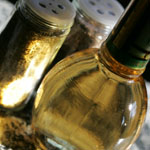Receiving and Storage of Food In The Restaurant
Food born illnesses can be spread when employees are not trained in how to receive and store food.
Receiving and Storing
Food received or used in food service establishments must be from sources approved by the health department. It must be clean, wholesome free from spoilage, misbranding, and safe for human consumption. The food must have been prepared, processed, handled, packaged and stored in a sanitary manner.
Storerooms should be well ventilated, free of dampness and free of pests and bugs.
Bulk products such as sugar and flour, can be emptied into tightly covered, properly labeled approved containers to prevent outside contamination. Storage containers must have openings large enough to allow easy cleaning between uses.
Food can not be stored in locker rooms, rest rooms, dressing rooms, garbage rooms, mechanical rooms, under sewer lines that are not shielded to intercept potential drips, under leaking water lines (including leaking automatic fire sprinkler heads) under Lines on which water has condensed, or under open stairwells.
Products must be stored on shelves or platforms 6 inches from the floor to ensure adequate cleaning of the storeroom floor. You don't want mop water contaminating your food.
Products must be stored on shelves or platforms 6 inches from the floor to ensure adequate cleaning of the storeroom floor. You don't want mop water contaminating your food.
Keep cleaning products, poisons and/or harmful products in storage Away from food storage areas to prevent contamination. Chemical products can drip on foods stored on shelves below. For protection against possible chemical poisoning, insecticide dispensers should not be within 12 feet of exposed food, food preparation, or serving areas or food contact surfaces. This includes all food equipment, utensils, tables, counters, and similar articles and space used in the preparation of food and drink.
Refrigeration
All food must be labeled and dated. Arrange containers apart from one another in a refrigerator to ensure proper cooling. This allows air to circulate around containers. Cover all food while in storage. Covering keeps food from drying out and minimizes the possibility of contamination.
In walk-in coolers, store all food on shelves . The food should be kept a least 6 inches off of the floor. The floor needs to be swept and mopped.
Store poultry and meats on the bottom shelves to prevent meat from leaking onto other foods.
Use foods on a first in, first out basis (fifo). Refrigerated, ready-to-eat, potentially hazardous food prepared and held for more than 24 hours in a facility must be marked with the date of preparation. It must be discarded if not sold or served within ten calendar days.
